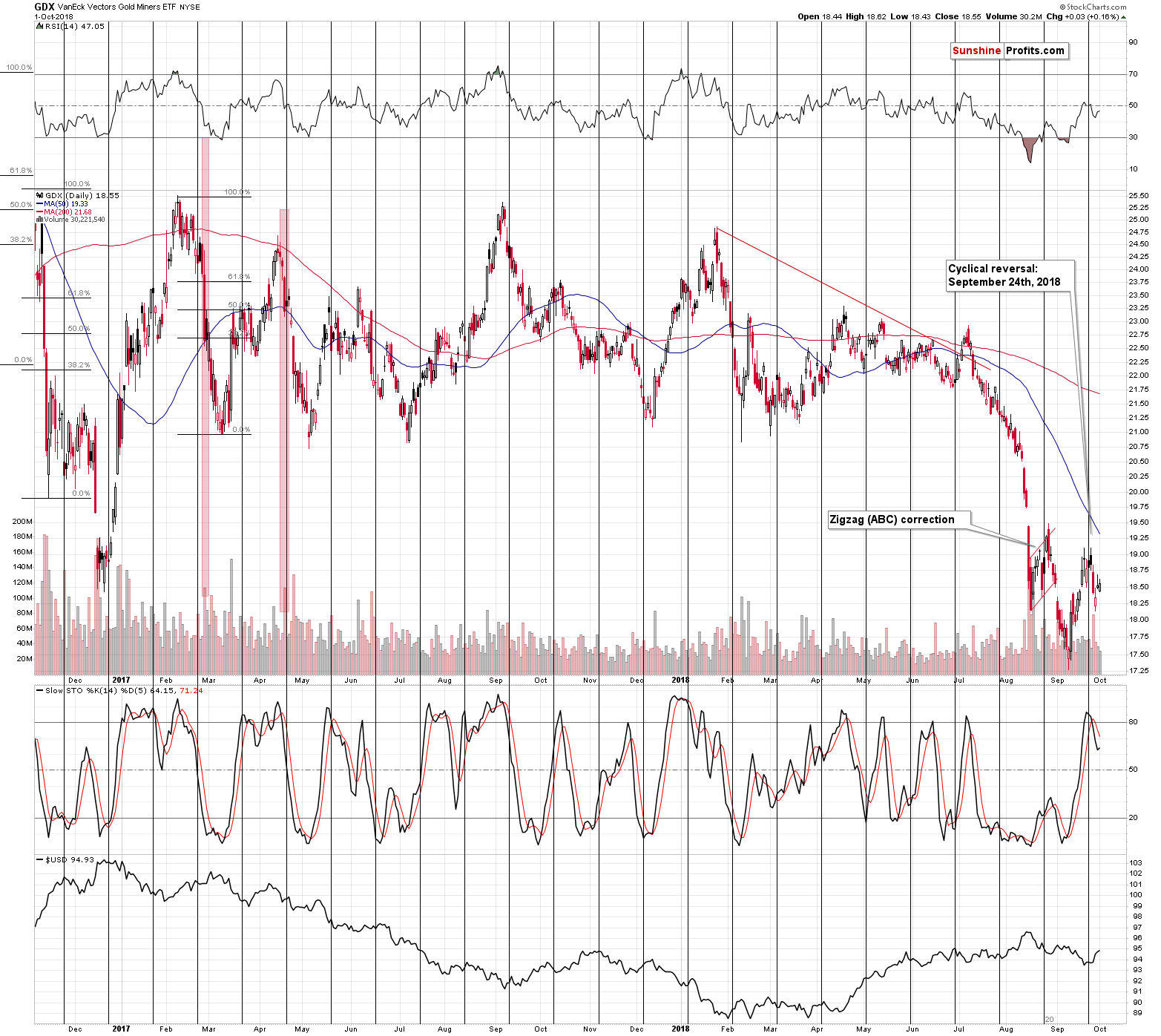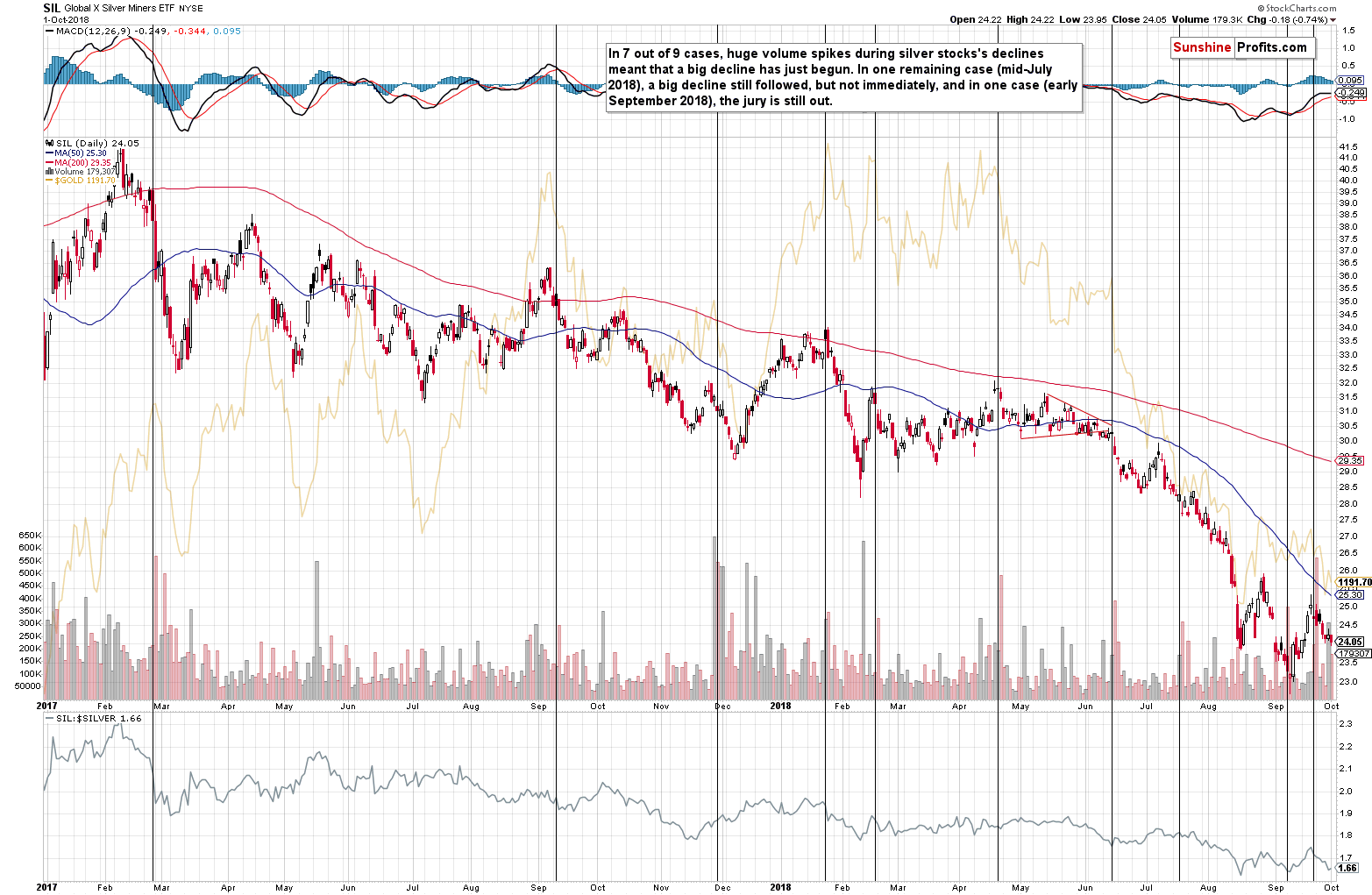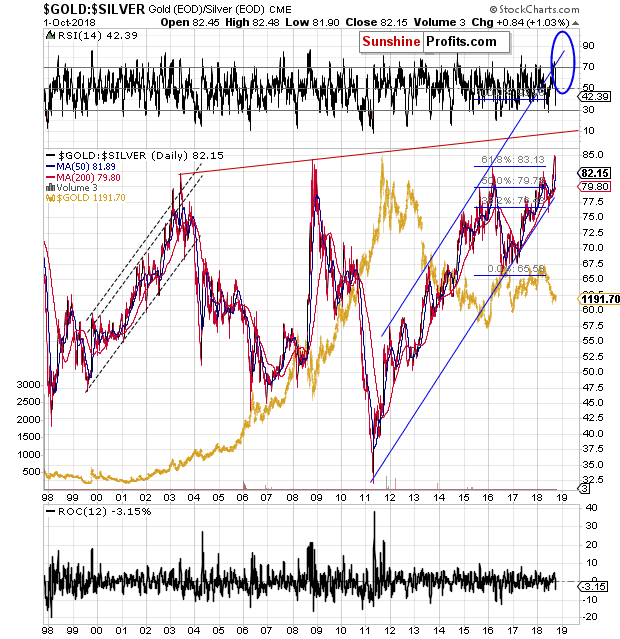Briefly: in our opinion, full (250% of the regular size of the position) speculative short positions in gold, silver and mining stocks are justified from the risk/reward perspective at the moment of publishing this alert.
Silver declined, just like it was supposed to. But, it declined only a bit. It didn’t even manage to erase the previous day’s gains. So, is the silver-reversal theory being invalidated? Is the link to 2013 no longer up-to-date?
It’s exactly the opposite. The 2013 link is even more confirmed as silver’s decline was almost exactly as what we saw in April 2013. Let’s take a look at the chart below for details (charts courtesy of http://stockcharts.com).
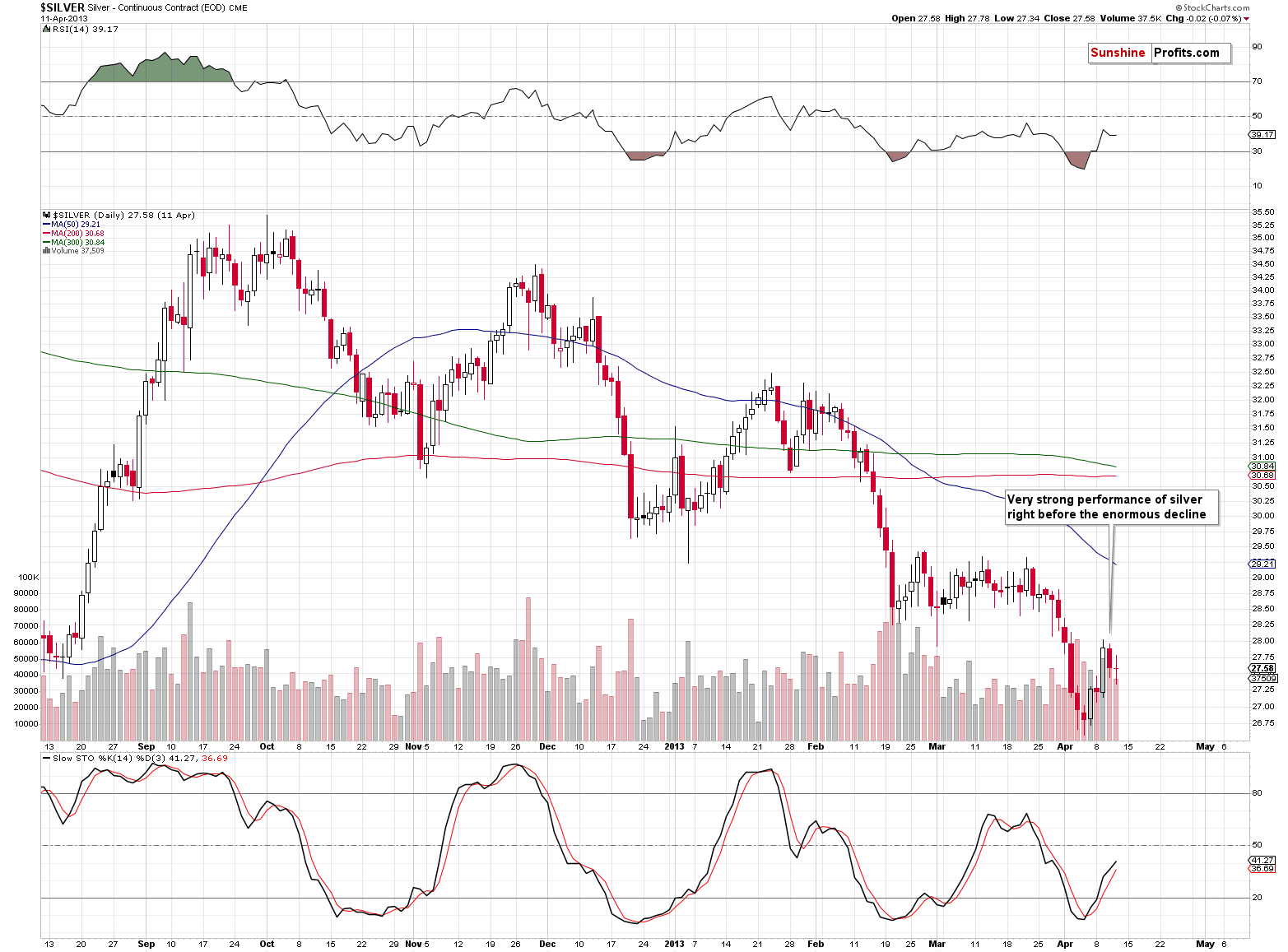
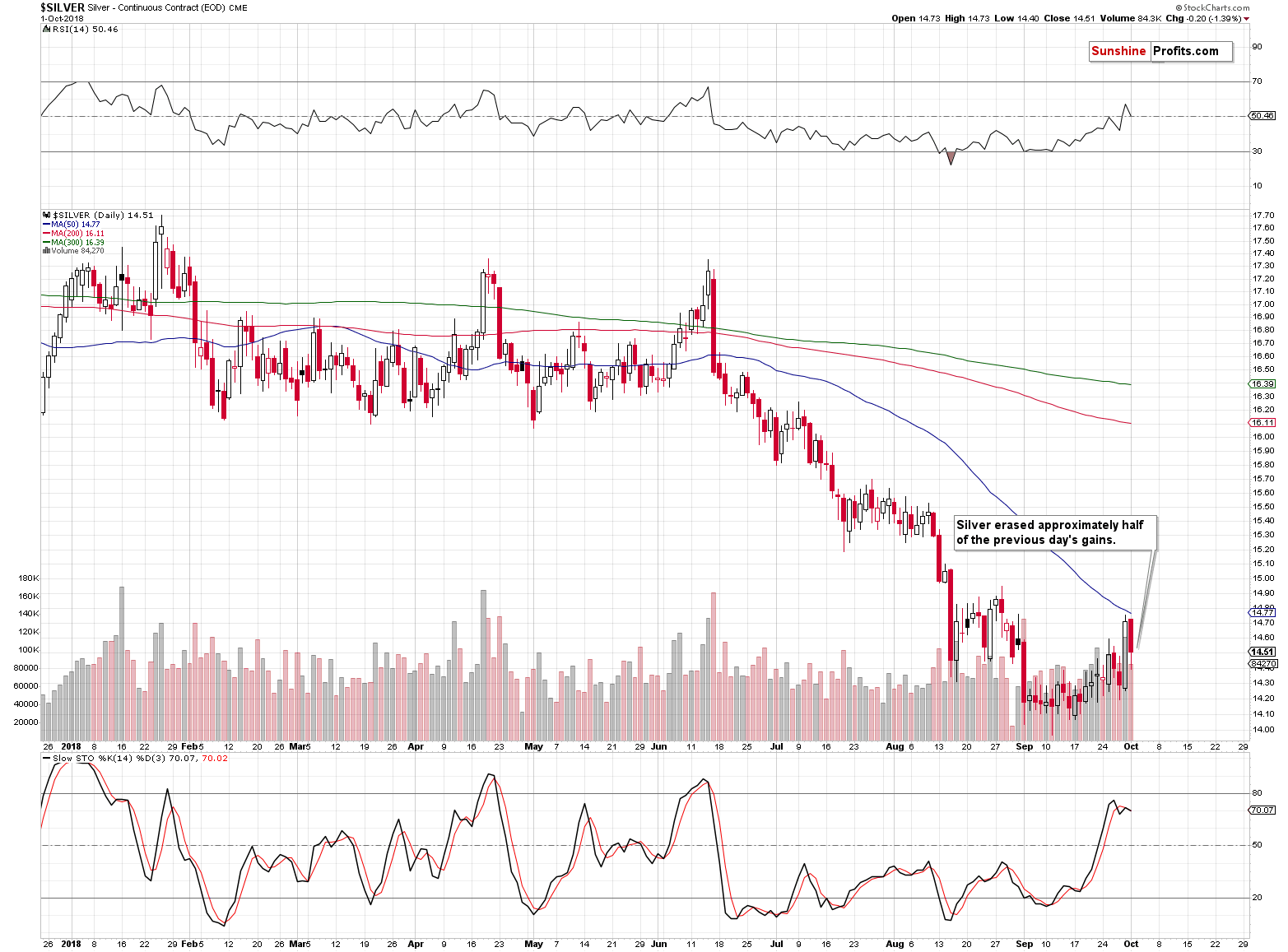
The above charts show what happened in silver right before the decline in April, 2013 and what happened yesterday. In both cases, silver soared (we provided the exact calculations yesterday) and then – again, in both cases – silver erased about half of the preceding daily rally. The similarity is striking and the implications are profoundly bearish.
What can we expect next? Most likely a daily pause and then an extreme decline. Naturally, the history doesn’t have to repeat itself to the letter and we might have a slightly longer delay before the big decline, or it might even start today.
Not much happened in gold yesterday, so let’s take a look at the mining stocks.
Mining Stocks Take a Small Breather
The GDX ETF moved a bit (only $0.03) higher yesterday and the move took place on low volume. It seems to have been just a pause during a decline. Why would we assume that this is a short-term decline? Because the miners reversed at their cyclical turning point, just as we indicated earlier, and the preceding move was a short-term, corrective upswing.
Moreover, please note that the sell signal from the Stochastic indicator is clearly visible, just like it was visible in the first half of July, when the big price decline was starting.
Silver Stocks’ Bearish Confirmation
As far as the silver stocks are concerned, we can also say that they are performing in tune with their previous signal. On September 25th, we wrote the following:
The silver stocks have not only declined, but they have done so on huge volume. We marked similar cases with vertical lines. In almost all cases since the beginning of 2017, when we saw declines on huge volume in the SIL ETF, it meant that a big decline is about to begin or that it’s already underway. The signal was reliable not only for silver stocks, but also for the rest of the precious metals sector. You can see how gold performed – its price is in the background of the chart.
Yesterday’s volume was the biggest that we saw in many months, which confirms the strength of the signal. The implications are very bearish.
Silver stocks declined and so did gold. Ironically, the underlying metal – silver – moved higher, but that only shows how artificial this move likely was.
On a side note, we were asked if the rally in silver might have been caused by options’ expiration. Our reply is that it might have been the case and it might have not been the case. Regardless of what the specific trigger was, the fact is that silver rallied profoundly while gold rallied only somewhat (gold options also expired), which has bearish implications.
If silver declined by about $0.50 on the options expiration date, you would almost certainly read “proof of silver manipulation!” in many articles that would be posted shortly after such a decline. Yet, there are no articles or posts suggesting price manipulation to the upside – interesting, isn’t it? Could it be that the “manipulation!” analysts are actually strongly biased toward long positions and are really gold and silver promoters, instead of being analysts? We’ll let you answer this question.
Moving back to the analysis, there’s one thing about silver that seems to have bullish implications for the precious metals sector.
Gold to Silver Ratio – Breakout’s Invalidation?
The gold to silver ratio recently moved above the previous highs and we wrote that this was not the ultimate target yet as the true long-term resistance is close to 100. But, the recent long-term breakout is being invalidated, which suggests that lower values in the ratio are ahead. Major tops in the ratio are generally followed by price increases in both precious metals.
The question is if the major top is indeed in. In our view, the jury is still out on this one. The ratio did decline, but it was impossible for silver to flash it’s epic sell signal – just like in 2013 – without this move in the ratio. So, should we really view the other side of the very bearish coin as bullish? No. At least not yet. While “the silver signal” works on a short-term basis (we should see a decline within the next few days), the breakout in the gold to silver ratio was a long-term phenomenon, so we should wait at least several days before really saying that the implications of the moves in the gold-silver ratio are really meaningful.
This means that the next several days will be quite decisive for the overall outlook for silver and thus for the rest of the precious metals market. If we don’t see a decline, the 2013 – 2018 link will eventually break and the move lower in the gold-silver ratio will become important. For now, the above-mentioned link remains in place and so do multiple other bearish factors.
Important Analyses
Before summarizing, we would like to emphasize that we have recently posted several analyses that are very important and that one should keep in mind, especially in the next several weeks. If you haven’t had the chance of reading them previously, we encourage you to do so today:
- Dear Gold Investor - Letters from 2013 - Analogy to 2013, which should make it easier to trade the upcoming sizable upswing (if enough factors point to it, that is) and to enter the market close to the final bottom.
- Gold to Soar Above $6,000 - discussion of gold’s long-term upside target of $6,000.
- Preparing for THE Bottom in Gold: Part 6 – What to Buy - extremely important analysis of the portfolio structure for the next huge, multi-year rally in the precious metals.
- Preparing for THE Bottom in Gold: Part 7 – Buy-and-hold on Steroids - description of a strategy dedicated to significantly boosting one’s long-term investment returns while staying invested in the PM sector.
- Gold’s Downside Target, Upcoming Rebound, and Miners’ Buy Plan - details regarding the shape of the following price moves, a buying plan for mining stocks, and a brief discussion of the final price targets for the current decline.
- Gold: What Happened vs. What Changed - discussion of the latest extreme readings from gold’s CoT report
- Key Factors for Gold & Silver Investors - discussion of key, long-term factors that support the bearish outlook for PMs. We are often asked what makes us so bearish – this article is a reply to this question.
- The Upcoming Silver Surprise - two sets of price targets for gold, silver and mining stocks: the initial and the final one.
- Precious Metals Sector: It’s 2013 All Over Again - comparison between 2013 and 2018 throughout the precious metals sector, the general stock market and the USD Index. Multiple similarities point to the repeat of a 2013-style volatile decline in the PMs.
Summary
Summing up, it seems that the next big downswing in the precious metals sector is already underway. We saw the repeat of silver’s short-term outperformance, which is a bearish sign on its own, and it’s particularly bearish because of the analogy to what happened in 2013 right before the big price slide. All in all, it seems that the huge profits on our short positions will soon become enormous.
As always, we’ll keep you – our subscribers – informed.
To summarize:
Trading capital (supplementary part of the portfolio; our opinion): Full short positions (250% of the full position) in gold, silver and mining stocks are justified from the risk/reward perspective with the following stop-loss orders and exit profit-take price levels:
- Gold: profit-take exit price: $1,062; stop-loss: $1,226; initial target price for the DGLD ETN: $82.96; stop-loss for the DGLD ETN $53.67
- Silver: profit-take exit price: $12.72; stop-loss: $15.16; initial target price for the DSLV ETN: $46.97; stop-loss for the DSLV ETN $31.37
- Mining stocks (price levels for the GDX ETF): profit-take exit price: $13.12; stop-loss: $19.61; initial target price for the DUST ETF: $80.97; stop-loss for the DUST ETF $33.37
Note: the above is a specific preparation for a possible sudden price drop, it does not reflect the most likely outcome. You will find a more detailed explanation in our August 1 Alert. In case one wants to bet on junior mining stocks’ prices (we do not suggest doing so – we think senior mining stocks are more predictable in the case of short-term trades – if one wants to do it anyway, we provide the details), here are the stop-loss details and target prices:
- GDXJ ETF: profit-take exit price: $17.52; stop-loss: $29.43
- JDST ETF: initial target price: $154.97 stop-loss: $64.88
Long-term capital (core part of the portfolio; our opinion): No positions (in other words: cash)
Insurance capital (core part of the portfolio; our opinion): Full position
Important Details for New Subscribers
Whether you already subscribed or not, we encourage you to find out how to make the most of our alerts and read our replies to the most common alert-and-gold-trading-related-questions.
Please note that the in the trading section we describe the situation for the day that the alert is posted. In other words, it we are writing about a speculative position, it means that it is up-to-date on the day it was posted. We are also featuring the initial target prices, so that you can decide whether keeping a position on a given day is something that is in tune with your approach (some moves are too small for medium-term traders and some might appear too big for day-traders).
Plus, you might want to read why our stop-loss orders are usually relatively far from the current price.
Please note that a full position doesn’t mean using all of the capital for a given trade. You will find details on our thoughts on gold portfolio structuring in the Key Insights section on our website.
As a reminder – “initial target price” means exactly that – an “initial” one, it’s not a price level at which we suggest closing positions. If this becomes the case (like it did in the previous trade) we will refer to these levels as levels of exit orders (exactly as we’ve done previously). Stop-loss levels, however, are naturally not “initial”, but something that, in our opinion, might be entered as an order.
Since it is impossible to synchronize target prices and stop-loss levels for all the ETFs and ETNs with the main markets that we provide these levels for (gold, silver and mining stocks – the GDX ETF), the stop-loss levels and target prices for other ETNs and ETF (among other: UGLD, DGLD, USLV, DSLV, NUGT, DUST, JNUG, JDST) are provided as supplementary, and not as “final”. This means that if a stop-loss or a target level is reached for any of the “additional instruments” (DGLD for instance), but not for the “main instrument” (gold in this case), we will view positions in both gold and DGLD as still open and the stop-loss for DGLD would have to be moved lower. On the other hand, if gold moves to a stop-loss level but DGLD doesn’t, then we will view both positions (in gold and DGLD) as closed. In other words, since it’s not possible to be 100% certain that each related instrument moves to a given level when the underlying instrument does, we can’t provide levels that would be binding. The levels that we do provide are our best estimate of the levels that will correspond to the levels in the underlying assets, but it will be the underlying assets that one will need to focus on regarding the signs pointing to closing a given position or keeping it open. We might adjust the levels in the “additional instruments” without adjusting the levels in the “main instruments”, which will simply mean that we have improved our estimation of these levels, not that we changed our outlook on the markets. We are already working on a tool that would update these levels on a daily basis for the most popular ETFs, ETNs and individual mining stocks.
Our preferred ways to invest in and to trade gold along with the reasoning can be found in the how to buy gold section. Additionally, our preferred ETFs and ETNs can be found in our Gold & Silver ETF Ranking.
As a reminder, Gold & Silver Trading Alerts are posted before or on each trading day (we usually post them before the opening bell, but we don't promise doing that each day). If there's anything urgent, we will send you an additional small alert before posting the main one.
=====
Latest Free Trading Alerts:
Over the last few days, the two most important people in the world held press conferences. What did they say and how can these remarks affect the gold market?
Two Press Conferences That Could Affect Gold Prices
=====
Thank you.
Sincerely,
Przemyslaw Radomski, CFA
Founder, Editor-in-chief, Gold & Silver Fund Manager
Gold & Silver Trading Alerts
Forex Trading Alerts
Oil Investment Updates
Oil Trading Alerts


